But first you have to acknowledge that everything in stroke is a complete failure.
Your 2030 Stroke Action Plan for Europe is a fucking waste. You didn't even talk to any of the 10 million yearly stroke survivors, Did you? The four points listed are not what survivors want. Survivors want 100% recovery and these problems in stroke needing to be solved.
Four over-arching
targets for 2030 were identified:
- To reduce the absolute number of strokes in Europe by 10%
- To treat 90% or more of all patients with stroke in Europe in a dedicated stroke unit as the first level of care (Care, NOT results)
- To have national plans for stroke encompassing the entire chain of care from primary prevention to life after stroke
- To fully implement national strategies for multisector public health interventions to promote and facilitate a healthy lifestyle, and reduce environmental (including air pollution), socioeconomic and educational factors that increase the risk of stroke.
SAFE(Stroke Alliance for Europe) calls upon politicians to give stroke the same attention given to cancer and mental diseases
Brussels, 28 March 2019- The Stroke Alliance for Europe (SAFE) organised today the event ‘Joining forces to prevent and control non-communicable diseases: The role of policy in tackling stroke’, under the patronage of the Romanian Presidency of the Council of the European Union, in Brussels, at the European Committee of the Regions. The event was organised by SAFE in collaboration with the European Stroke Organisation and the Romanian National Stroke Association.The panel participants have put many proposals on the table. The most important request is for forming a stroke related sub-group for the purpose of facilitating the implementation of the Stroke Action Plan for Europe, the same as has been done for cancer and mental health.
As Jon Barrick, SAFE President stressed in his opening speech, the topic discussed today is of extreme importance: Stroke is the second most common cause of death in Europe, with nearly one hundred thousand (988,000) deaths each year[1]. In Europe, over 13% of women and 9% of men die from this disease (data from the MEP Hearth Group of the European Parliament).
 In
2018, SAFE and ESO released the “Stoke Action Plan for Europe
2018-2030”, which proposes a holistic approach to stroke management,
from prevention to acute care, rehabilitation and life after stroke. The
report sets out minimum targets to be reached by every European
country, to equilibrate the quality of care across Europe.
In
2018, SAFE and ESO released the “Stoke Action Plan for Europe
2018-2030”, which proposes a holistic approach to stroke management,
from prevention to acute care, rehabilitation and life after stroke. The
report sets out minimum targets to be reached by every European
country, to equilibrate the quality of care across Europe.“Romania is definitely trying to put an end to inequalities in stroke care across the country, and we hope to see the same thing achieved at European level” said Tiberius-Marius Brădățan, Secretary of State, Ministry of Health of Romania. “We think that this is now possible thanks to the Stroke Action Plan for Europe that SAFE and ESO have released. If implemented, the Action Plan will underpin the step change in stroke care that is required to reduce the devastating impact that this condition has on individuals, their families and Member States’ economies.”
Effective healthcare planning and adequate resource allocation across Europe is needed to deal with this public health challenge, taking into account that the emotional and financial burden of stroke is largely borne by stroke survivors themselves and their families.
“Stroke remains a major cause of disability and death, but the opportunities to curb the effects of stroke have dramatically improved”- said Prof. Bo Norrving, who chaired the European Action Plan for Stroke 2018-30 steering committee, adding “While we are discussing the implementation of the European Stroke Action Plan, strokes continue to occur, and patients continue to get substandard care – becoming disabled or dying. Time to go from table to practice is now!”
Sorin Tuță, Vice-president of the Romanian National Stroke Association (ANRS), said that although Romania faces 61.500 new strokes each year, things have significantly improved in the past several years, especially in the domain of the acute stroke treatment, with 32 new stroke ready hospitals in 2019.

SAFE President and the representatives from the Romanian EU Presidency
Prof. Tiina Laatikainen, from the Institute of Public Health and Clinical Nutrition, Finland, said that, even though the emergency care well organized and those hospitals not having neurologists 24/7 achieve consultancy by telestroke service, there are still challenges, such as endovascular treatments not available 24/7 in the whole country due to lack of angioradiologists, less than 15 % of patients achieve adequate rehabilitation and every fourth working aged stroke patient do not return to work (disability pension).
Thanking all discussion participants and the EU Romanian Presidency and the Committee of Regions for their support, Jon Barrick concluded the session by saying: “We have the scientific community and patients aligned. We have the will of European, national and regional decision-makers, and industry partners who are here today to give their support to future activities aimed at improving stroke prevention, treatment and research. I would therefore like to call upon the future European leaders, and upon the Member States, to work together to achieve the 2030 goals as set by the “2030 Stoke Action Plan for Europe.”
No comments:
Post a Comment